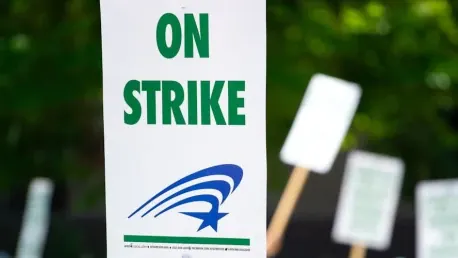With the holiday rush in full swing, unionized Amazon warehouse workers have initiated a strike targeting various locations across the United States. Workers in New York City, Atlanta, Southern California, San Francisco, and Skokie, Illinois, have joined the picket lines, with more expected to join, according to the Teamsters union. The main reasons behind the strike include Amazon’s refusal to recognize and negotiate with union chapters, along with grievances concerning low wages, union-busting activities, and hazardous working conditions. This industrial action occurs at a critical time, potentially disrupting the holiday shipping surge and spotlighting workers’ rights issues within e-commerce giants.
The Strike’s Scope and Reasons
The union, representing thousands of drivers and warehouse workers across ten facilities, has organized picket lines at numerous Amazon Fulfillment Centers, sending a strong message across the network. They are calling on other warehouse workers and drivers, even those without collective bargaining agreements, to participate in the strike. Remarkably, there is no planned end date for this strike, reflecting the severe frustration among the workforce. Teamsters General President Sean O’Brien has sharply criticized Amazon’s apparent lack of negotiation, accusing the company of placing greed over worker welfare and suggesting that the strike could lead to delays in holiday packages.
Amazon, however, has sought to downplay the strike’s impact, stating that its operations remain unaffected and characterizing the strike as a public relations tactic. According to Amazon, the demonstrations involve mostly non-Amazon workers, purportedly outsiders brought in to harass and intimidate their team. A spokesperson for the Teamsters union has disputed this claim, affirming that actual Amazon workers are actively participating in the strike. Despite these heated accusations, Amazon has refrained from giving specific details about any current discussions with the workers, instead emphasizing that employees are at liberty to unionize and that the company prefers to engage directly with its workforce without an intermediary.
Amazon and Workers’ Perspectives
Amazon has pointed to recent improvements in working conditions and pay as evidence of its commitment to its employees. These include increased starting wages and free Prime memberships for employees. Despite these asserted improvements, almost 10,000 Amazon workers have reportedly joined the Teamsters, demanding higher wages, better benefits, and safer work environments. For many, like driver Gabriel Irizarry from Skokie, Amazon’s current pay rates do not suffice to meet their financial needs, as they struggle to afford their bills despite the company’s assurances of worker care and attention to welfare.
This strike is not an isolated event, coming nearly two years after the Teamsters established a division specifically aimed at mobilizing Amazon workers. The effort has been bolstered by the involvement of the Amazon Labor Union, which joined the initiative earlier this year. Additionally, the timing of the strike aligns with a recently released U.S. Senate report that alleges Amazon’s warehouses pose unique dangers to workers. Amazon has dismissed these claims as outdated and misleading, adding another layer of complexity to the ongoing dispute between labor and management within the company.
Broader Implications and Next Steps
Amid the busy holiday season, unionized Amazon warehouse workers have commenced a strike at multiple locations throughout the United States. Employees in New York City, Atlanta, Southern California, San Francisco, and Skokie, Illinois, have taken to the picket lines, with the Teamsters union indicating that more workers are expected to join. The strike is driven by several issues, primarily Amazon’s refusal to acknowledge and negotiate with union chapters. Additionally, workers are protesting against low wages, anti-union practices, and unsafe working conditions. This protest comes at a particularly crucial time, threatening to disrupt the holiday shipping rush and bringing attention to workers’ rights within major e-commerce companies. As the holiday demand escalates, the strike underscores ongoing labor tensions and the struggle for better conditions and fair treatment for workers in the e-commerce sector. The industrial action highlights the broader issues within the industry, emphasizing the need for significant changes in how labor relations are managed by large corporations like Amazon.









